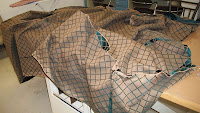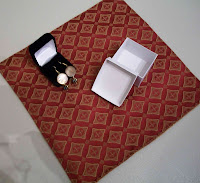 Alright, wedsday you were left with a bunch of cut pieces...now to assemble.
Alright, wedsday you were left with a bunch of cut pieces...now to assemble.When sewing a tablecloth, I normally sew the top together (if I need too for short bolts), then sew the individual side pieces together, the sew the sides together, hem the bottom, and lastly....sew the top on. Some people sew the hem last, but I find that it's easier to do before I sew the top on as weight is a big consideration when sewing drapery or upholstery projects together. Also, all seams are 3 thread stitched for strength unless otherwise stated. You can do this with a combo stitch if you have an embroidery stitch, standard you have a serger, or if you only have a straight stitch machine, sew the same line 3 times.

 1. Sew the top together. You do not need to do this if your bolt was wide enough to cut in one piece. I normally pin the two halves together. Remember to use a reinforced stitch to sew. Drapery fabric is heavy. I used the basic 12 stitch on the Janome, but you can use something else.
1. Sew the top together. You do not need to do this if your bolt was wide enough to cut in one piece. I normally pin the two halves together. Remember to use a reinforced stitch to sew. Drapery fabric is heavy. I used the basic 12 stitch on the Janome, but you can use something else.I did a black thread on white fabric sample for you to see the stitch better. This is a combination straight
 stitch and zigzag stitch for durability in multiple directions. It's also good for sewing fabric that is going to have a lot of wear and tear.
stitch and zigzag stitch for durability in multiple directions. It's also good for sewing fabric that is going to have a lot of wear and tear.2. Iron your top flat. First, remove the T-pins you put in. Next, heat up your iron to the appropriate setting. I normally use a higher setting with lots of steam for upholstery fabric. It seems to need a little extra. Some people skip ironing, but it's the difference between so-so finished pro
 duct and
duct and  AMAZING. On the top, you are going to iron the fold open so that you can see both halves. After you are done, flip the piece and iron the other side on the reverse.
AMAZING. On the top, you are going to iron the fold open so that you can see both halves. After you are done, flip the piece and iron the other side on the reverse.Viola, nice shiny flat piece. Set the top piece to the side. You will come back to it later.
3. Assemble the sides. You are going to do the same step 4
 times. With each side, pin the matching hem piece to it (short to short and long to long) and sew together. I normally place the smaller piece on top as it makes it easier to sew.
times. With each side, pin the matching hem piece to it (short to short and long to long) and sew together. I normally place the smaller piece on top as it makes it easier to sew.4. Iron the sides flat. This time you will iron toward the hem. Hems
 are always ironed so that when completed, they naturally fall with gravity. If ever in doubt as to which way to steam a hem, you can hold up the piece of fabric in the direction it will fall when completed and this will give you a good way to literally see the fabric pull in one direction or another. Flat seams at the top or bottom get ironed flat.
are always ironed so that when completed, they naturally fall with gravity. If ever in doubt as to which way to steam a hem, you can hold up the piece of fabric in the direction it will fall when completed and this will give you a good way to literally see the fabric pull in one direction or another. Flat seams at the top or bottom get ironed flat.5. Pin the sides together. Now comes one of two tricky parts. You have all these lovely sides with lines running through them, but they may or may not
 match exactly. Match the lines in your fabric together, this means the top and bottom may not match exactly. AND THAT'S OK. You ad
match exactly. Match the lines in your fabric together, this means the top and bottom may not match exactly. AND THAT'S OK. You ad ded a couple extra inches to give yourself wiggle room in the pattern at the beginning. Don't sweat it. We will handle those irregularities in a sec.
ded a couple extra inches to give yourself wiggle room in the pattern at the beginning. Don't sweat it. We will handle those irregularities in a sec.Carefully, pin each short side to each matching long side. You should have a giant slinky at the end.
6. Sew the 4 sides together. I normally hold the point where the lines come together
 in my feeding hand to make sure
in my feeding hand to make sure everything lines up properly. As you can see from the photo, mine didn't line up exactly at each end. The important part was I got the hem lines even.
everything lines up properly. As you can see from the photo, mine didn't line up exactly at each end. The important part was I got the hem lines even.7. Iron that baby flat. Each side seam will be ironed flat. Remember to flip it and iron both sides flat. This is a really good point to stop and double-check your work. The lines should meet up as close to perfect as possible. This is the line people will see running around the table when they look at it and it's important for it to be even and uniform.
Stop and take a break at this point. You've probably been sewing or cutting for a bit.



8. Check your edges. Remember back when I said not to worry if the top and bottom of your sides didn't match exactly because we would deal with them later? Well, this point is later. Lay the sides flat on a table at the side seams so you can see if t
 hey
hey match up. Grab your scissors and starting with one side, cut the longer side even with the shorter side, tapering it off.
match up. Grab your scissors and starting with one side, cut the longer side even with the shorter side, tapering it off.Slowly, going around...do each side. Then when you've done one side, flip the piece and double-check the other side. Sometimes you can miss one side or the other when doing
 this.
this.When you are done, both sides should look smooth like this. You are now ready to add the hem.
9. Add the hem. What to do with the hem? That's always a question. I was going to originally do this fab corded edge, but the client wasn't too thrilled about it so after consultation, I settled on a basic turned-hem at the

 bottom. It worked well and they were pleased. Simply fold twice and stitch around with straight stitch.
bottom. It worked well and they were pleased. Simply fold twice and stitch around with straight stitch.If you have fun attachments, you can do all cool kinds of things, but for most people....zip zip.
10. Attaching the top. Last piece whew...pin each corner of the top to the corner of the sides, then work your way pinning across. You may have to ease some into each side if you're off an inch or two
 here or there, but overall it should be good. The whole thing looks monstrous when you are done. If it looks like a giant slug and keeps falling off the sides of your cutting table, you've probably done it right.
here or there, but overall it should be good. The whole thing looks monstrous when you are done. If it looks like a giant slug and keeps falling off the sides of your cutting table, you've probably done it right.11. Sewing the top to the sides. This part should be familar. Go around sewing the top to the sides, take particular care in the corners
 to pivot the foot.
to pivot the foot.12. Iron flat. Alright, you're done. Throw over pool ta
 ble, step back to admire your work and all good.
ble, step back to admire your work and all good.Until next week, have a great weekend everyone.



































